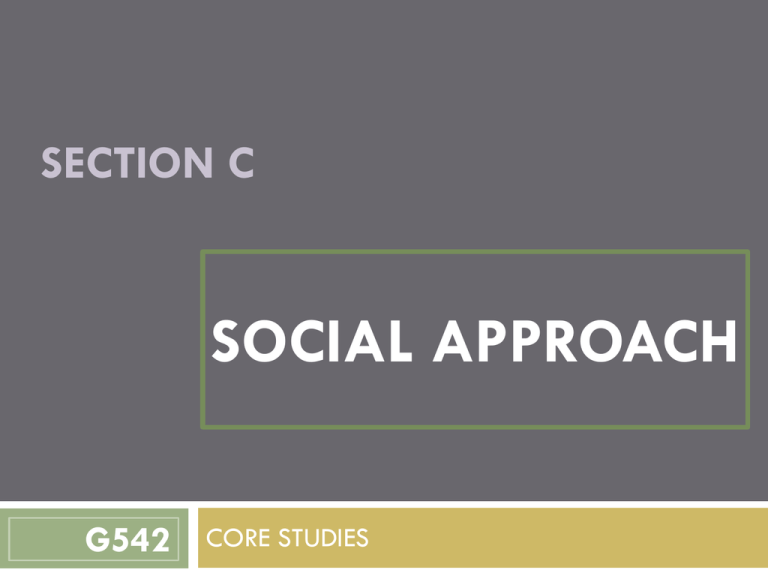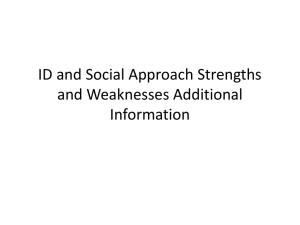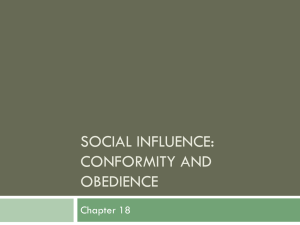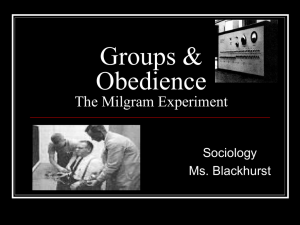Social Approach
advertisement

SECTION C SOCIAL APPROACH G542 CORE STUDIES Exam Style Question EXAMPLE a. b. c. d. Outline one assumptions/implication of the Social approach. (2) Describe how the social approach could explain__________ . (4) Describe one similarity and one difference between any studies that take the social approach. (6) Discuss strengths and weaknesses of the social approach using examples from studies that take this approach. (12) Social Approach BACKGROUND The main classical approach in psychology. It is the study of interactions and group behaviour. We spend much of our time with other people, family, friends, institutions and culture. Social means involving two or members of the same species Social behaviour involves activity within a group or between groups We can study the way people interaction and influence each other. AREAS OF INTEREST Social Approach Social Psychologists study human behaviour in a social context. They often focus on group dynamics, interpersonal relations and how people interpret and deal with the behaviour of others. Milgram, 1963 Reicher & Haslam, 2006 Piliavin , 1969 RESEARCH METHODS Social Approach The key methods that social psychologists used are observations and experiments, although self report techniques are also used. Milgram: Laboratory Reicher & Haslam: Laboratory with self-report Piliavin: Field EXAM STYLE QUESTIONS (ESQ) Approaches MILGRAM January 2011 a. Outline one assumption of the Social Approach. (2) b. With reference to Milgram’s study describe how the Social Approach can explain obedience. (4) c. Describe one similarity and difference between any studies that take the Social Approach. (6) d. Discuss the strengths and weaknesses of the Social Approach using examples from any studies that could be viewed from this approach. (12) EXAM STYLE QUESTIONS (ESQ) Approaches REICHER & HASLAM Example a. Outline one assumption of the Social Approach. (2) b. With reference to Reicher & Haslam’s study describe how the Social Approach can explain tryanny. (4) c. Describe one similarity and difference between any studies that take the Social Approach. (6) d. Discuss the strengths and weaknesses of the Social Approach using examples from any studies that could be viewed from this approach. (12) EXAM STYLE QUESTIONS (ESQ) Approaches PILIAVIN 2009/ 2013 (Same set of questions asked twice) a. Outline one assumption of the Social Approach. (2) b. With reference to Piliavin’s study describe how the Social Approach can explain helping behaviour. (4) c. Describe one similarity and difference between any studies that take the Social Approach. (6) d. Discuss the strengths and weaknesses of the Social Approach using examples from any studies that could be viewed from this approach. (12) Resources: Social Approach Internet PowerPoint Exam Style Questions (ESQ) Activity 1 Worksheet 1: KEY WORDS Complete the key terms related to this topic You can use the resources and internet to help Each definition should be at least two sentences long You should use these terms where appropriate in your responses to exam questions Activity 2 Worksheet 2: Assumptions & Evaluation Complete the summary table You can use the resources and internet to help a. Outline one assumptions of the social approach. (2) a. Outline one assumptions of the social approach. (2) 2 MARK QUESTION Point: Assumption of the approach Elaborate: Provide evidence from the study. 2. SOCIAL APPROACH ASSUMPTIONS & EVALUATION Main Assumptions What are the main assumptions of the Social Approach? What does the social approach assume about our behaivour? What has a strong influence on the way in which we behave? According to the social approach what is often a more accurate explanation of social behaviour? According to the social approach what are a major influence on an individual’s behaviour? What is social psychology divided into? Strengths What information can the social approach provide? What methodology does the social approach mainly use? Why is this method beneficial? Limitations What are the problems with social studies that use laboratory experiments? Why is it problematic to use field experiments? What does the researchers unable to do? What ethical issues are raised by social research? Why might social studies go out of date? What can limit the usefulness of social studies? 2. Key Assumptions of the Social Approach: 1. 2. 3. All behaviour occurs within a social context this means that________________. For example,_____________________________. Other people and the society that has been created are a major influence on people’s behaviour. This means that___________________________________. For example,_______________________________. An individual’s behaviour is affected by situational factors such as the environment or upbringing. This means that__________________________________. For example,_________________________________. 2. Assumptions of the... Social Approach Social Psychology is divided into two areas: Social interaction (how individual’s interact and how status in society influences behaviour); and social cognition (how thoughts and emotions about current social situations influence behaviour). Assumption 1: All behaviour occurs within a social context even when nobody else is present Assumption 2: Our behaviour is not always the results of our own free will. The situation we are in will have a strong influence on how we behave. The surrounding environment effects an individual’s behaviour, thought processes and emotions. Assumption 3: Situational (environment + upbringing) rather than individual explanations of social behaviour are often more accurate as context and culture has a strong influence on how we behave. 2. SOCIAL APPROACH STRENGTHS STRENGTH 1: The research is often clearly related to real life situations which can produce insight into human behaviours which can produce useful information. STRENGTH 2: A wide range of research methods and techniques are used to study social interactions. STRENGTH 3: One strength of the social approach is that it can explain why people behave in extreme ways. 2. SOCIAL APPROACH LIMITATIONS LIMITATION 1: It can reduce the importance of the individual not taking into account individual differences (underestimates what people bring into a social situation). LIMITATION 2: It has one of the worst track records in ethics. Most social research, because of the necessary complexity to try and create socially meaningful situations means that ethical guidelines have been broken through lack of consent, deception etc. LIMITATION 3: Deterministic and overstates situational factors and underemphasises the individual differences and the role of ‘free will’ Activity 3 Worksheet 3: Supporting Research Complete the summary table on supporting research for the social approach You can use the resources and internet to help b. With reference to ______________ study describe how the Social Approach can explain ______ (4) b. With reference to ______________ study describe how the Social Approach can explain ______ (4) PEC 4 MARK QUESTION Point: Assumption of the approach + a conclusion from a study (don’t mention who wrote the study yet) Evidence: Provide evidence from the study. Comment: Link the study to the point you began with. 3. SOCIAL APPROACH SUPPORTING RESEARCH Study Identify 3 studies that use the social approach BEHAVIOUR & APPROACH With reference to the relevant study, describe how the social approach can explain the following behaviours •Obedience •Tyranny •Helping SAMPLE Outline detail of the sample for each study. Include details such as: age, gender, ethnicity, total number METHOD Identify the main method used by each study. If appropriate, include details of the design, IVs and/or DVs 3. Milgram: Obedience BEHAVIOUR & APPROACH The social approach, as demonstrated through Milgram’s study, could explain obedience. First, as Milgram himself suggested, the environment – Yale University – may have influenced participants with regard to the worthiness of the study and the competence of the experimented, resulting in high levels of obedience that might not be found in a less prestigious setting. Second, the presences of what appeared to be a legitimate authority figure, dressed in a white lab coat, carrying a clipboard, may have influenced the participants behaviour, as they believed him (through socialisation) to be a trustworthy and knowledgeable individual who should be obeyed. SAMPLE 40 Male participants. 20-50yrs. Volunteer sampling METHOD Laboratory Experiment. 3. How does the social approach explain obedience? Obedience is explained by: Socialisation: From a very early age we are taught, firstly by our parents and then by teachers, to obey through rewards and punishments. This process of learning norms and values is called socialisation. We learn that obeying legitimate authority is the ‘right’ thing to do. This could explain the high levels of obedience (65%) in Milgram’s study. Agentic State: Milgram suggested that when people work in isolation they rely on their own conscience, but this becomes suppressed when they work within a social system, in other words, when people enter a social set up that involves a hierarchy (layers of power) they automatically see themselves as an agent of others and their conscience stops operating. This is known as the agentic state. In the agentic state people do not feel responsible for their own actions, they transfer blame to the person giving the order – ‘I was only following orders, it’s not my fault!’ In Milgram’s study – participants could have been in the ‘agentic state’ by blaming the authority figure for what they were doing (shocking innocent person). Plan your answer: PEC Point: According to the social approach behavior occurs within a social context, which has norms and values. Therefore from an early age we are taught these rights and norms, for example obeying an authority figure. Therefore, people are likely to be obedient, even in morally wrong situations if an authority figure is present. PEC Example: For example in Milgram’s study 65% of participants obeyed the authority figure, even though they knew they were harming the learner with an electric shocks. Comment: The Social Approach can therefore explain obedience, as demonstrated through Milgram’s, study that the participants obeyed because they have been taught d to obey an authority figure and therefore, justified their actions with I was told to give electric shocks. 3. R+H: Tyranny BEHAVIOUR & APPROACH This study focuses on the influence of social interaction and the effect of group identity and group inequalities. The study shows oppression to be the product of active processes of social identification, which can also form the basis is for both tyranny and resistance. Conflict, abuse and tyranny do not necessarily result from zombie-like compliance, but rather from individuals active identification and engagement with the groups that promote them. SAMPLE 15 male participants from 332 volunteers (self-selected sample) METHOD Laboratory Experiment (although recreation of a real environment). Could be seen as a controlled case study. 3. How does the social approach explain Tyranny? Define tyranny: dominance through threat of punishment and violence Explain link with social approach: • The way in which members of a group behave may be pro or anti social, and depends on the norms & values of the group social identity. It is the breakdown of groups, and powerlessness that creates the conditions for tyranny. It shows that failing groups create problems for their own members, and for others, because when people cannot create a social system they will accept extreme solutions proposed by others. This shows that all behaviour is created within a social context and other people have a major influence on our behaviour. 3. Piliavin: Helping BEHAVIOUR & APPROACH The environment and situation we are in have a major influence on whether or not individuals will help another person. This study showed that when in a closed area, individuals then not to diffuse responsibility by sharing it among those present; rather they feel personally responsible, and so offer help to a victim in need of assistance. Findings from the study showed that the more people that were present when the incident occurred, the more people went to help the victim. They also found that the condition of a victim influenced helping behaviour: if a victim is lame, people are more likely to help than if the person is drunk. SAMPLE 4,500 men and women who used the subway between 11.00-3.00pm between April 15th – June 26th 1968. 45% black 55% white. METHOD Field Experiment 3. How does the social approach explain Helping Behaviour? Helping behaviour is explained through the cost-reward model in a given situation (e.g. costs = risk of harm, benefits = feeling good, praise). They argue that firstly, observation of an emergency situation creates an emotional arousal in bystanders. This arousal may be perceived as fear, disgust or sympathy, depending on aspects of the situation. Study showed that we are more likely to help someone who we perceive as being in the same ‘group’ as us (evidence of same race helping). Secondly, we are more likely to help if we see someone else helping (modelling effect). One can also see the diffusion of responsibility in different situations whereby people are less likely to help if they see that other people are present. However, this effect was not observed in Piliavin’s study as participants couldn’t escape the emergency situation. Activity 4 Worksheet 4: Similarities & Differences Part 1: Brainstorm Part 2: Grid C. Describe one similarity and one difference between any studies that take the social approach. (6) How to structure this answer: PEE Describe one similarity and one difference between any studies that take the social approach. (6) Comparison Questions always needs to use: Point, Evidence, Evidence Point: Evidence: Evidence: How to structure this answer: PEE Describe one similarity and one difference between any studies that take the social approach. (6) Comparison Questions always needs to use: Point, Evidence, Evidence Point: One similarity between Milgram and Reicher and Haslam is that they both used observation. Evidence: For example, in Milram’s study he observed how high the participants gave electric shocks to the ‘learner and also he observed the reactions’ of the participants as they were administering electric shocks. Evidence: For example, in Reicher and Haslam’s study they observed the participants using video cameras, which recorded the behaviour of the participants. 4. SOCIAL APPROACH SIMILARITIES & DIFFERENCES Ecological Validity: how realistic is it; can the findings be applied to everyday life? Longitudinal and snapshot: is the study conducted over a long period or one point in time? Qualitative and Quantitative data: is the data descriptive or numerical? Usefulness: how is the research useful in terms of how it explains human behaviour? Application: how can the results of the research be applied in everyday life settings Ethics: consent/informed consent, deception, withdrawal, debriefing, confidentiality, protection of participants, observation without consent Generalisability: can these findings be applied to all individuals/situations? Validity: is the method used within the research measuring what it is supposed to? 4. SOCIAL APPROACH SIMILARITIES & DIFFERENCES Determinism and Free will: Does this study/perspective suggest we have freewill or that our behaviour/experience is determined Reductionism and Holism: do the results of the study focus on one single level of explanation, ignoring others or do they consider many explanations? Nature and Nurture: is this characteristic/behaviour due to genetics or learning? Individual and situational explanations: can this behaviour be explained by the situation/environment or is it due to personal characteristics Ethnocentrism: can this behaviour be considered to be biased towards one ethnic group or society? Psychology as a Science: is the method used within the study rigorous, ie. objective, reliable, falsifiable? 4. SOCIAL APPROACH S&D: MILGRAM & R+H SIMILARITY 1: Both studies measured behaviour in a controlled environment (lab setting) SIMILARITY 2: Both studies used the same sampling method. DIFFERENCE 1: Milgram’s study was extremely unethical, whereas R & H showed its possible to design a study within an ethical framework. DIFFERENCE 2: Milgram’s study did not involve a manipulation of an IV to see the effect it would have on the DV as it was not an experiment. It was an observational method with features of an experiment (controlled environment). However, R & H had a number of IVs. 4. Comparison between studies: Milgram & R+H SIMILARITY Similarity 1: Both studies measured behaviour in a controlled environment (lab setting) Evidence Milgram: In Milgram’s study, obedience to authority was measured in a controlled setting in a lab unique to individuals (university). Evidence R+H: Similarly, R+H’s study was carried out in a film studio which was made into a prison. This was to allow for easier replication and standardised procedures to be carried out and to measure behaviour in a controlled manner so a causal link could be established. Both of these studies therefore lack EV as it was an artificial environment. Similarity 2: Both studies used the same sampling method. Evidence Milgram: Milgram’s study used only males and selected them through a self-selected (volunteer) method. This involved advertising in the newspaper for males who wanted to take part in a study on memory & learning. Evidence R+H: Similarly, R & H also used a self-selected method by advertising in the national press and through leaflets for male participants. In both studies, from the pool of applicants, participants were chosen of different ages and backgrounds to ensure diversity. 4. Comparison between studies: Milgram & R+H DIFFERENCE Difference 1: Milgram’s study was extremely unethical, whereas R & H showed its possible to design a study within an ethical framework. Evidence Milgram: Milgram distressed his participants severely by deceiving them about the true aim of the study and making them believe that they were giving real shocks to other human beings. This caused them to sweat, tremble and some had seizures. Evidence R+H: R & H on the other hand, had paramedic guards on duty to ensure the study was running smoothly, they carried out medical and background checks to ensure that participants were not at risk to others and were not psychologically vulnerable. It was also approved by the ethics committee board and the study could be stopped (which it was) at any time if it got unethical or distressing for others. Difference 2: Milgram’s study did not involve a manipulation of an IV to see the effect it would have on the DV as it was not an experiment. It was an observational method with features of an experiment (controlled environment). However, R & H had a number of IVs. Evidence R+H: manipulated permeability (if participants thought they could move between prisoner & guard groups), legtimacy (when participants were told that there were actually no differences between groups) and cognitive alternatives (when a new prisoner arrives who they thought would negotiate between prisoners and guards to find new regimes for the prison. Evidence Milgram: Milgram wanted to initially look at different nationalities which would have been the IV but did not end up doing so therefore his study did not have an IV and is considered a controlled observation. 4. SOCIAL APPROACH S&D: MILGRAM & PILIAVIN SIMILARITY 1: Both studies had problems with ethics and could both be accused of inflicting harm on participants. SIMILARITY 2: Both studies gathered quantitative & qualitative data. DIFFERENCE 1: : Milgram did debrief his participants whereas Piliavin et al did not. DIFFERENCE 2: Piliavin’s study was carried out in a natural environment whereas Milgram’s study was carried out in a controlled environment (lab). 4. Comparison between studies: Milgram & Piliavin SIMILARITY Similarity 1: Both studies had problems with ethics and could both be accused of inflicting harm on participants. Evidence M: In Milgram, many participants displayed signs of extreme stress, such as sweating, trembling and even seizures. This shows that participants were not protected from harm. Evidence P: In Piliavin et al’s study, participants – passengers on the subway train who witnessed someone apparently collapse also may well have experienced some degree of stress. Watching someone collapse and deciding whether or not to intervene is quite stressful. Some participants left the carriage indicating that they could not bear to be close to the situation. Similarity 2: Both studies gathered quantitative & qualitative data Evidence M: Milgram’s study used observations in a lab setting to observe participants reactions/behaviour when shocking another person. In addition, they interviewed participants after the study using attitude scales to check their state of well-being. Evidence P: Piliavin et al’s study gathered quantitative data by measuring how long it took one to help and the % of trials in which help was given by race and condition of victim. In addition, qualitative data was gathered by noting the comments made by passengers (participants) on the train. 4. Comparison between studies: Milgram & Piliavin DIFFERENCE Difference 1: Milgram did debrief his participants whereas Piliavin et al did not. Evidence M: In Milgram’s study participants had overtly volunteered to take part in the experiment and had come to the lab and taken part on a one-to-one basis. Each participant was reunited with the learner to show that he hadn’t been hurt and the aims of the deceptions of the study were fully explained. Evidence P: However, Piliavin et al did not debrief his participants, maybe because there were so many and it would be difficult to do this (people getting on and off trains) and maybe because there was someone concern that it might affect people’s behaviour on future trials if it started to be known that an experiment was taking place involving a supposed ‘victim’ collapsing. Difference 2: Piliavin’s study was carried out in a natural environment whereas Milgram’s study was carried out in a controlled environment (lab). Evidence P: Piliavin et al chose a subway train in New York where there would be multiple bystanders but relatively easy to control the interventions – that is someone collapsing. This means that his study has high EV. Evidence M: Milgram’s study on the other hand was in Yale University in a lab setting. This was done to allow for standardised procedures to be used and easier replication and more control of participants behaviour. They measured obedience by measuring how far up the shock generator the participant would go if the learner got an answer wrong. This is an artificial setting and task which makes the study low in EV. 4. SOCIAL APPROACH S&D: R+H & PILIAVIN SIMILARITY 1: Both use an experimental method SIMILARITY 2: Both studies gathered quantitative & qualitative data. DIFFERENCE 1: Piliavin chosen a natural situation whereas R & H chose a controlled situation (lab). DIFFERENCE 2: The number and gender of the participants varied in both studies. 4. Comparison between studies: R+H & Piliavin SIMILARITY Similarity 1: Both use an experimental method Evidence P: Piliavin’s study is a field experiment and they manipulated the race and condition of the victim that collapsed, as well as the timing for the model interventions. Evidence R+H: Manipulated permeability (if participants thought they could move between prisoner & guard groups), legtimacy (when participants were told that there were actually no differences between groups) and cognitive alternatives (when a new prisoner arrives who they thought would negotiate between prisoners and guards to find new regimes for the prison. This allows both to see cause & effect. Similarity 2: Both studies gathered quantitative & qualitative data Evidence P: Piliavin et al’s study gathered quantitative data by measuring how long it took one to help and the % of trials in which help was given by race and condition of victim. In addition, qualitative data was gathered by noting the comments made by passengers (participants) on the train. Evidence R+H: also used quantitative data which involved psychometric tests on several variables such as organisational, social and clinical and they gathered qualitative data by recording participant’s behaviour through observation. 4. Comparison between studies: R+H & Piliavin DIFFERENCE Difference 1: Piliavin chosen a natural situation whereas R & H chose a controlled situation (lab). Evidence: Piliavin et al chose a subway train in New York where there would be multiple bystanders but relatively easy to control the interventions – that is someone collapsing. This means that his study has high EV. Evidence R+H: In contrast, R & H did not conduct this study in a real prison. Maybe it was because we they would not have had enough experimental control over the situation if the participants were mixing with real prisoners and guards and also because there might be more ethical dangers if real prisoners or guards became aggressive. This study had low EV as the setting was artificial and does not really tell us how prisoners and guards behave in a normal prison. Difference 2: The number and gender of the participants varied in both studies. Evidence P: In Piliavin’s study, a large sample was used. This consisted of 4450 males and females who go on the subway train. Evidence R+H: However, R &H’s sample consisted of 15 participants – 5 guards and 10 prisoners who were all male. This makes the results less generalisable as they were all male and a small number. However, Piliavin’s is more representative to the general population as he used both males and females and a big sample to measure helping behaviour. Activity 5 Worksheet 5: Strengths & Limitations D. Discuss strengths and weaknesses of the social approach using examples from studies that take this approach. (12) NB: Each study must be used at least once in this question How to structure this answer: PEC a. Discuss strengths and weaknesses of the social approach using examples from studies that take this approach. (12) Evaluation Questions always needs to use: Point, Evidence, Comment Point 1:The research is often clearly related to real life situations which can produce insight into human behaviours which can produce useful information. Evidence for this: Comment (why is this a strength): NB: Each study must be used at least once in this question. 5. SOCIAL APPROACH STRENGTHS & WEAKNESSES STRENGTH 1: The research is often clearly related to real life situations which can produce insight into human behaviours which can produce useful information. STRENGTH 2: A wide range of research methods and techniques are used to study social interactions. STRENGTH 3: One strength of the social approach is that it can explain why people behave in extreme ways. WEAKNESS 1: It can reduce the importance of the individual not taking into account individual differences (underestimates what people bring into a social situation). WEAKNESS 2: It has one of the worst track records in ethics. Most social research, because of the necessary complexity to try and create socially meaningful situations means that ethical guidelines have been broken through lack of consent, deception etc. 5. SOCIAL APPROACH STRENGTHS Point 1: The research is often clearly related to real life situations which can produce insight into human behaviours which can produce useful information. Evidence for this: For example, one of the reasons there was so much research into helping was a national outrage about Kitty Genovese. The general public could not understand why no one had helped her despite there being a large number of witnesses. Piliavin helps to explain this phenomenon in terms of his model of response – there were lower levels of arousal because the witnesses were some distance from Kitty – upstairs in apartment buildings. Also, the perceived costs of helping would have been very high – they might face danger themselves, it might be some sort of trap and so on. Comment (why is this a strength): This research is therefore helpful for giving insight into important social questions because it helps one understand the reasons to why individuals may help or not in different emergency situations which is relevant to society. 5. SOCIAL APPROACH STRENGTHS Point 2: A wide range of research methods and techniques are used to study social interactions. Evidence: In Milgram’s study of obedience, a range of methods and techniques were used. The study was carried out in lab conditions making it experimental in nature and highly controlled. In addition, an observational technique was used whereby participants were observed through a one-way mirror on their reactions when shocking the learner. In addition, participants were interviewed after the study and were given various attitude scales to ensure they would leave in a state of well-being. Comment: This increases the validity of the study as various methods were employed in order to gain both quantitative and qualitative data and using a range of methods allows for different behaviours to be investigated. For example, using interviews helps obtain direct information from the participant themselves about how they left and measuring obedience in an experimental manner can help explain results in a more causal manner. In addition, an observational technique helps look at participants behaviour directly by observing them rather than interpreting their behaviour. 5. SOCIAL APPROACH STRENGTHS Point 3: One strength of the social approach is that it can explain why people behave in extreme ways. Evidence: For example, Milgram concluded that people will harm other people if they are told to do so by an authority figure. 65% of participants administered 450 V, as instructed but the authority figure, to the learner even though they knew that they were hurting them. Comment: This is strength as the Social Approach can help to explain events why such events like the Holocaust occurred and therefore prevent them from occurring again. (notice how this is linking back to the point). In Milgram’s case he demonstrated the impact of the authority figure and how authority figures can cause extreme behaviours. (Notice how this is linking back to the study) 5. SOCIAL APPROACH WEAKNESSES Point 1: It can reduce the importance of the individual not taking into account individual differences (underestimates what people bring into a social situation). Evidence: In Reicher & Haslam’s study, it does not take into consideration that the individuals (prisoners) may have a disposition to behave in an aggressive and uncooperative manner and the guards in that particular study were generally less vocal and authoritative because of the type of people they were. It may be their personality that caused the breakdown of the groups to take place rather than the lack of shared identity between the groups. Comment: This suggests that studies within the social approach tend to focus more on the situational factors that cause behaviour to take place rather than what type of individual takes part in the study and their personality that may cause the behaviour to occur. Reicher & Haslam focused on the group processes (identification) at the expense of the personality. Personality is still important and could probably explain why some people did stand up against the guards and why the guards did not have the power. The social approach therefore does not take a holistic view. 5. SOCIAL APPROACH WEAKNESSES Point 2: It has one of the worst track records in ethics. Most social research, because of the necessary complexity to try and create socially meaningful situations means that ethical guidelines have been broken through lack of consent, deception etc. Evidence: Piliavin’s study was unethical as none of the participants could give their consent as it was a covert experiment. In addition none of the participants were debriefed because they were not aware of the experiment in the first place. Participants were also deceived into believing that someone was ill and drunk and really needed help. This could have also caused some distress as participants get worried about their own safety and whether or not they should help etc. Comment: This is a weakness because one has to ensure that there is no long-term damage to the participants. However, one has to look at the costs vs benefits and because social studies look at issues which are part of everyday life, it is difficult to investigate them without breaking some of these ethical guidelines. However, if the issue is of benefit to the individual and society (in this case helping behaviour) then the benefits may outweigh the costs and at times may be justified by some. Activity 6 Worksheet 6: Social Approach Revision Outline 3 assumptions of the Social Approach Outline strengths Outline limitations D. Discuss strengths and weaknesses of the social approach using examples from studies that take this approach. (12) NB: Each study must be used at least once in this question Activity 7 Worksheet 7: Exam Practice 12 Mark Plan Discuss the strengths and weaknesses of the Social Approach using examples from any studies that could be viewed from this approach. (12) EXAM STYLE QUESTIONS (ESQ) Approaches MILGRAM January 2011 a. Outline one assumption of the Social Approach. (2) b. With reference to Milgram’s study describe how the Social Approach can explain obedience. (4) c. Describe one similarity and difference between any studies that take the Social Approach. (6) d. Discuss the strengths and weaknesses of the Social Approach using examples from any studies that could be viewed from this approach. (12) EXAM STYLE QUESTIONS (ESQ) Approaches REICHER & HASLAM Example a. Outline one assumption of the Social Approach. (2) b. With reference to Reicher & Haslam’s study describe how the Social Approach can explain tryanny. (4) c. Describe one similarity and difference between any studies that take the Social Approach. (6) d. Discuss the strengths and weaknesses of the Social Approach using examples from any studies that could be viewed from this approach. (12) EXAM STYLE QUESTIONS (ESQ) Approaches PILIAVIN 2009/ 2013 (Same set of questions asked twice) a. Outline one assumption of the Social Approach. (2) b. With reference to Piliavin’s study describe how the Social Approach can explain helping behaviour. (4) c. Describe one similarity and difference between any studies that take the Social Approach. (6) d. Discuss the strengths and weaknesses of the Social Approach using examples from any studies that could be viewed from this approach. (12)









